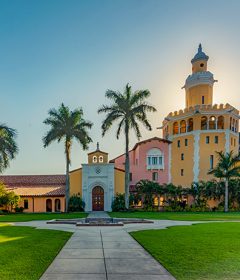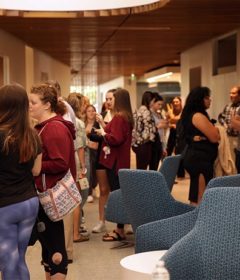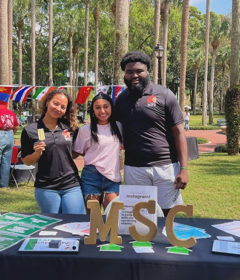One Man’s Trash: Art Students create “Disorderly Construct”
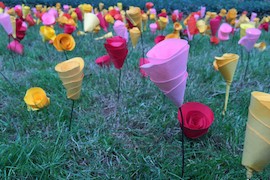
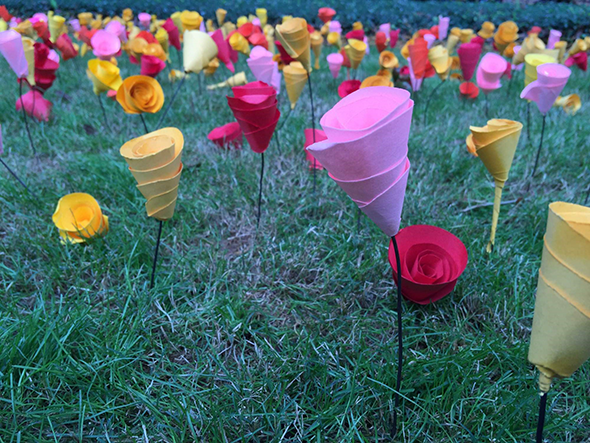
It was another picturesque day at Stetson. The leaves were autumn-falling, and the fountain shimmered underneath the Florida sun. But as you cast your eyes on the endless greenery, something was amiss.
There, between the palm trees, stood multiple columns of garbage.
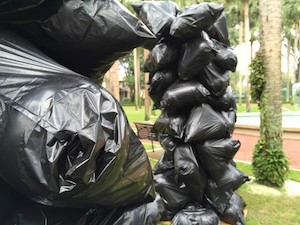
The beautiful flowers near the library were not flowers at all, but construction paper creations. There were colored fish nets within the trees, crumpled up money embedded in the grass, seeds and moss laying outside Elizabeth Hall, a giant bird’s nest on the ground, hanging plastic pieces and destroyed baby cribs propped up where the hammocks should hang—all for the sake of art. Beautiful, temporary art.
Brittany Metz, an acclaimed art professor in the midst of her first year at Stetson, proposed the idea for her studio art sculpture and mixed media classes. In collaboration, the students planned to display their large scale pieces right in the center of campus, rightly naming the Palm Court exhibition “Disorderly Construct.”
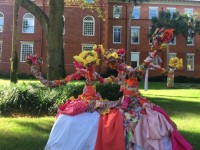
“We chose that name because that area is very pristine and manicured. Our art would interrupt that, but still complement the aesthetic.” said Metz. She offered a vital piece of instruction: “Make something people notice.”
Before the students set out to build, Metz worked with faculty to shut off the sprinklers, and, more importantly, alerted the media.
“This is not only something the students would be able to put on their resumes as professional experience,” said Metz. “It’s their opportunity to say something to the community.”
For their project proposal, students had to include a sketch of the piece, its location on the quad, where they drew inspiration from, what materials were being used—and how they were going to remove it.
Art has an innate duplicity, seemingly effortless; however for many students, this project claimed blood, sweat and tears.
Natasha Radovicz Schaidt, senior studio art major, created the piece, “Let There Be Color,” pictured at the top of this page, by individually hand-rolling 1,000 flowers. “I did about 200 to 300 flowers a day,” said Schaidt. “That’s what I did over Thanksgiving Break.”
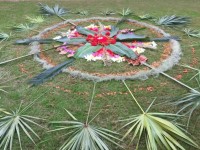
Inspired by the rebellious spirit of wildflowers, Schaidt created a sensory experience by blasting the campus with vibrancy through beautiful chaos. Needless to say, the removal process was bittersweet. “Flowers wilt,” said Schaidt.
Gisela Alvarez, senior art and art history major, and Dillan Hoekzema, junior digital arts major, were at the center of a social media controversy for their piece, “The Rest Was Left Behind,” colloquially known as the ‘garbage sculpture,’ pictured above, left.
Although left open for interpretation, given nothing but the title, the minimalist sculpture was inspired from Alvarez’s own story.
“Right before I came to Stetson, I had to leave an abusive relationship, a marriage of nine years,” said Alvarez. “I didn’t have time to pack everything. I only had time to fill three garbage bags.”
She had to leave behind years of collected sentimentalities such as books, clothes, pictures and a box of art supplies.
“It was hard to let go,” said Alvarez. “Essentially I had to think of them as trash.”
Shifting away from decorative art, this project enabled Alvarez to do her most minimal piece. “It asks a lot from the viewer, but there’s a lot of concept behind it.”
The crux of project was to provoke thought. “It should be more than just a pretty thing,” said Metz.
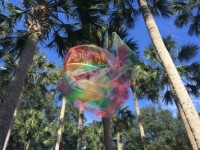
Despite the resounding message and praise from art professors, some students believed the piece marred the campus.
“All over YikYak it was trashed,” said Alvarez. “No pun intended.”
Reading comments such as “any idiot could put together garbage bags,” Alvarez chose to take it in stride, commenting on the feedback herself: “I’m the artist. Ask me anything.”
“As an artist you have to absorb negative criticism,” said Alvarez. “If art isn’t pissing somebody off, you’re doing it wrong.”
Every piece of featured art took hours of grueling work and dedication to complete. However, this campus disruption soon gave way to normalcy.
“The nature of this work is not long-lasting,” said Metz. The Palm Court has eventually reverted back to its natural order, as if these pieces were never there.
Although many students were reserved about the removal process, many did see a benefit of the display’s fleeting nature.
“Everything in life is temporary,” said Jozefin Logu, senior psychology major. Zachary Prather, junior Spanish major, observed that removing the pieces increased its impact.
“When something is at some place for a long time, we get accustomed to it and don’t notice it anymore,” said Prather. “This way it has more of a lasting effect.”
Paula Villagomez, senior international business major and art minor, presented a similar sentiment. “Something that stays there forever eventually declines,” said Villagomez. “When it’s temporary, art remains as good as it was when you first placed it there.”
Though the paper flowers have been plucked, and the garbage pillars have long been knocked down, “Disorderly Construct” will not die out. Metz will ensure that.
“I plan on doing it again next semester.”
For more information on the pieces that were on display and the artists who created them, please visit https://disorderlyconstructblog.wordpress.com/
By Veronica Faison

